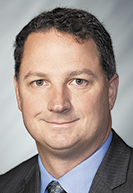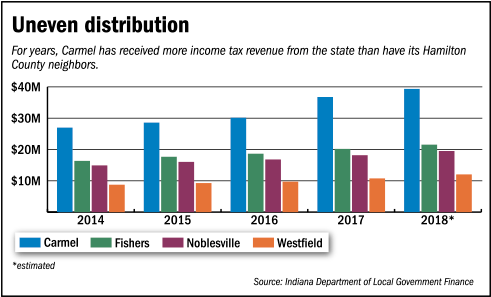Subscriber Benefit
As a subscriber you can listen to articles at work, in the car, or while you work out. Subscribe NowThe local income tax a Fishers resident pays does not actually go to the city of Fishers. Neither does the tax paid by a Carmel resident go to Carmel. At least not directly.
 Fadness
FadnessInstead, all income taxes paid by Hamilton County residents are collected into one pot and then distributed to local governmental units based on a state-mandated formula that takes into account a community’s property tax levy and the amount of income taxes the city received the previous year.
It’s not a new formula, but Fishers leaders are fed up with it. They say the northern suburb is owed more than it receives and they want lawmakers to direct changes.
Mayor Scott Fadness said Fishers should be receiving an amount similar to Carmel’s, given that the neighboring communities have nearly the same population and similar median household income levels.
But Carmel actually receives millions of dollars more each year.
For every person living in Fishers in 2018, the city will receive an estimated $239 in income tax revenue, while Carmel will receive $432 per resident.
That equates to Fishers’ collecting nearly $18 million less than Carmel next year.
“To put that in perspective, you could pay for my entire fire department and half of my police department” with the additional amount Carmel receives, Fadness said. “This is something that’s becoming a glaring issue in Hamilton County.”
Fishers isn’t alone in its plight. Noblesville and Westfield also receive less money per resident than Carmel does.
 And even when evaluating the revenue by income, Carmel comes out the big winner.
And even when evaluating the revenue by income, Carmel comes out the big winner.
For every $1 in median household income reported by the U.S. Census Bureau, the city of Carmel receives nearly $370. In Fishers, it’s just $225. And in Westfield, it’s even less—just $140 per $1 of median household income.
The disproportionate effect ripples throughout the county because the state attributes a specific amount of income tax revenue to each county that is then divided among the various taxing bodies. So, if one community receives a bigger slice of the pie, another gets less.
In Hamilton County, Carmel receives about a quarter of the pie, while Fishers receives about 14 percent. Fadness is trying to convince lawmakers to amend the distribution formula to spread the money more evenly.
“This has been brought up before, but frankly legislators just sort of glossed over it, because mainly, I think, Fishers hadn’t grown to a point where people said, ‘This is an apples-to-apples comparison,’” Fadness said. “But now, I think most people would say these are two pretty similar communities and this disparity is substantial.”
That could mean a cut in revenue for Carmel, which Mayor Jim Brainard said could hurt the city’s fiscal standing because Carmel issued debt believing revenue would be there to pay it.
“Cities have relied on the state rules, and the system they laid out for us,” Brainard said. “To change it in the middle of a period when you have bonds issued would be bad fiscal policy.”
Jeff Spalding, who spent 13 years as fiscal analyst for the Republican caucus in the Indiana House, said changes to the way income taxes are distributed are likely—eventually—because the current structure isn’t intuitive.
“Logic and reason do tend to prevail in the long haul,” said Spalding, who is now the controller for Noblesville.
Rep. Todd Huston, R-Fishers, said it’s an issue worth taking a look at.
“It appears there is an inequity in the system when you compare apples to apples with Carmel and Fishers,” said Huston, who serves on the Ways and Means Committee, which considers all tax and budget issues. “It’s hard not to see those numbers and be confused.”
Breaking it down
Local option income tax rates and distributions vary among counties. In Hamilton County, a 1 percent tax is collected. Applying the state formula, the Indiana Department of Local Government Finance estimates Hamilton County will receive $153.5 million in 2018. That will be split among the county, four cities, nine townships, four towns and five public libraries.
To determine the distribution breakdown, the DLGF takes each entity’s property tax levy (the total amount a taxing entity collects), adds the income tax revenue received the previous year and subtracts the amount of property taxes collected for debt issued after June 2005. The DLGF then takes that figure and calculates what percentage it is of all the taxing units.
The convoluted process is why communities don’t necessarily reap the full benefit of income taxes paid by their own residents. Other taxing bodies within the county also get a cut of those residents’ taxes.
Spalding said the discrepancies in Hamilton County boil down to the property tax levy, because that’s really the only part of the formula that is variable.
Carmel’s property tax levy is regularly higher than that of Fishers—in 2017, it was $55.2 million, compared to $37.7 million in Fishers.
But cities don’t have much control over their tax levies because, for decades, the state has determined the maximum amount each community can collect and caps how much it can grow every year, Spalding said.
So communities that were well established and had larger levies when the tax limits went into effect generally collect more money than those with populations that grew more recently. That then affects the income tax distribution.
A municipality can increase its levy in a few other ways—by annexing more property, appealing to the state for an exception due to high assessed-value growth, or adding a debt levy.
 Brainard
BrainardHowever, any debt levy added after 2005 is subtracted in the equation, meaning Carmel’s recent debt doesn’t increase its income tax distribution.
Even so, Fadness argues that the damage to the income tax revenue distribution had already been done because Carmel had substantial debt issued before the 2005 cutoff.
“I don’t blame Mayor Brainard for what he did,” Fadness said. “Those were the rules, but the implications have been this completely distorted revenue distribution.”
Brainard said he acted in the best interests of his residents.
“We purposely did everything we could to maximize the funding we get out of that formula. Fishers chose not to,” Brainard said. “I understand why Mayor Fadness is frustrated, because it happened before his time.”
 Spalding
SpaldingSpalding said the debt component should resolve itself, because “eventually no one will have pre-2005 debt.”
But Fadness said that, even after that debt is retired, the formula will still help Carmel because it accounts for the amount a city received the previous year, and Carmel is already starting at a higher level.
“It trails off over a really long period of time,” he said.
Spalding said the underlying structure of the equation has “locked in some differences,” but to determine how big the disparity has grown between Fishers and Carmel or any other Hamilton County entities, someone would have to analyze data back to when income tax collection started.
“Untangling that ball is … close to impossible,” Spalding said.
Fixes?
 Huston
HustonNone of the local leaders contacted by IBJ know what a fair distribution would look like.
“Fairness is in the eye of the beholder,” Huston said. “All we’re doing here is dividing a pot. If your slice is bigger, then someone else’s is smaller. It’s as simple as that.”
Fadness doesn’t have what he thinks is a solution yet, either. But he said a variety of options are worth consideration, even freezing the amount Carmel receives until the other entities catch up.
A tweak specific to Hamilton County is more appropriate, he said, because a statewide change would be too complicated to address quickly.
But Huston said he’d prefer to consider an overall solution that addressed similar problems in other counties and didn’t further complicate the system.
 “I think we want to look at what the distribution can look like when you have commonality between units,” Huston said. “Nobody says there can’t be a difference. … But between two common units, should there be that big of difference?”
“I think we want to look at what the distribution can look like when you have commonality between units,” Huston said. “Nobody says there can’t be a difference. … But between two common units, should there be that big of difference?”
Huston said he hasn’t discussed the topic with other lawmakers yet, but conversations will likely pick up as the 2018 session nears.
For now, there is one benefit to the current structure—the state is responsible for collecting and distributing the funds, which saves local governments the expense of doing so.
“It’s certainly imperfect in terms of the allocation, but the cost to administer it at the local level is very, very small because it’s being done at the state level,” Spalding said. “They’re still avoiding the cost of having to collect it themselves.”•
Please enable JavaScript to view this content.
